ISS: RUBI (Reference mUltiscale Boiling Investigation)
Non-EO
ESA
Science
Quick facts
Overview
| Mission type | Non-EO |
| Agency | ESA |
| Launch date | 25 Jul 2019 |
ISS Utilization: RUBI (Reference mUltiscale Boiling Investigation)
Launch Mission Status RUBI Science References
Liquid vapor flows exist in a wide variety of applications in both normal gravity and reduced gravity environments. As it is usually the case, there are many benefits and drawbacks in the use of two-phase systems and, consequently, serious considerations are needed before deciding on whether or not to proceed with the design, construction and use of these systems, particularly in a reduced-gravity context. 1)
RUBI is a fluid science experiment developed and built by Airbus for ESA (European Space Agency). The overall objective is to investigate the fundamentals of boiling fluids in microgravity. RUBI will study the phenomena of phase transition and heat transfer during the evaporation of fluids in microscopic and macroscopic dimensions.
On Earth – thanks to the effect of gravity – only small bubbles form, quickly detaching from the heating surface and masking other physical effects. The scientists want to optimize their numerical models of the boiling process with a series of tests conducted under microgravity conditions and corresponding reference tests on Earth. In the future, this could contribute towards the production of more efficient and environmentally friendly household appliances (stoves, radiators) and heat exchangers for industrial manufacturing processes.
Boiling is a two-phase heat transfer process where large heat fluxes can be transferred with small driving temperature differences. The high performance of boiling makes the process very interesting for heat transfer applications and it is widely used in industry for example in power plants, refrigeration systems, and electronics cooling. Nevertheless, due to the large number of involved phenomena and their often highly dynamic nature a fundamental understanding and closed theoretical description is not yet accomplished. The design of systems incorporating the process is generally based on empirical correlations, which are commonly accompanied by large uncertainties and, thus, has to be verified by expensive test campaigns. Hence, strong efforts are currently made to develop applicable numerical tools for a reliable prediction of the boiling heat transfer performance and limits. In order to support and validate this development and, in particular as a precondition, to enhance the basic knowledge about boiling the comprehensive multi-scale experiment RUBI (Reference mUlti-scale Boiling Investigation) for the Fluid Science Laboratory on board the ISS is currently in preparation. 2) 3)
The scientific objectives and requirements of RUBI have been defined by the members of the ESA topical team "Boiling and Multiphase Flow" and addresses fundamental aspects of boiling phenomena. The main objectives are the measurement of wall temperature and heat flux distribution underneath vapor bubbles with high spatial and temporal resolution by means of IR thermography accompanied by the synchronized high-speed observation of the bubble shapes. Furthermore, the fluid temperature in the vicinity and inside of the bubbles will be measured by a micro sensor array. Additional stimuli are the generation of an electric field above the heating surface and a shear flow created by a forced convection loop. The objective of these stimuli is to impose forces on the bubbles and investigate the resulting bubble behavior such as bubble sliding on and detaching from the surface. The experiments benefits from the absence of vapor buoyancy and natural convection in the high quality and long-term microgravity of the ISS. Effects and phenomena like thermocapillary convection that are hardly observable in normal gravity conditions can be investigated. Clearly predefined conditions particularly of the thermal layer at the heating surface can be established without disturbances by natural convection. Vapor buoyancy as the main detaching force in normal gravity is missing. Hence, it is possible to study stationary, attached bubbles and alternative detaching forces. With RUBI a long history of boiling experiments is perpetuated that used microgravity as a tool for a deeper understanding of the fundamental phenomena. Several precursor experiments closely related to the RUBI project have already been conducted on parabolic flights. The subject of the paper is to provide an overview on the RUBI project, its scientific objectives and the corresponding experimental principle. The current design of the experiment container that is under development at ASTRIUM Space Transportation in Friedrichshafen will be introduced. Furthermore, results from the precursor experiments are presented. The industrial activities of the RUBI project are funded and the science team is supported by ESA.
RUBI instrument
RUBI’s core element is a cell filled with fluid, which can be heated and cooled thermoelectrically. The boiling process is then triggered on a metal-coated glass heater using a laser. High-resolution cameras record the formation and growth of vapour bubbles in both the visible and infrared spectrum. By taking up to 500 images per second, RUBI’s cameras can create a three-dimensional representation of the bubble shapes and analyze the temperature distribution on the heater, enabling the scientists to precisely determine evaporation conditions and heat flux densities. The boiling process can be systematically influenced using a high-voltage electrode (up to 15,000 V) and an adjustable convection loop.
A particular challenge for the Airbus-led industrial team was to shrink RUBI down to the size of a ‘shoe box’ (40 x 28 x 27 cm) weighing just 34 kg that would then be suitable for use in space. By comparison, a terrestrial laboratory setup would be approximately the size of a wardrobe (2 x 1 x 1 m) and would have a mass of ~300 kg.
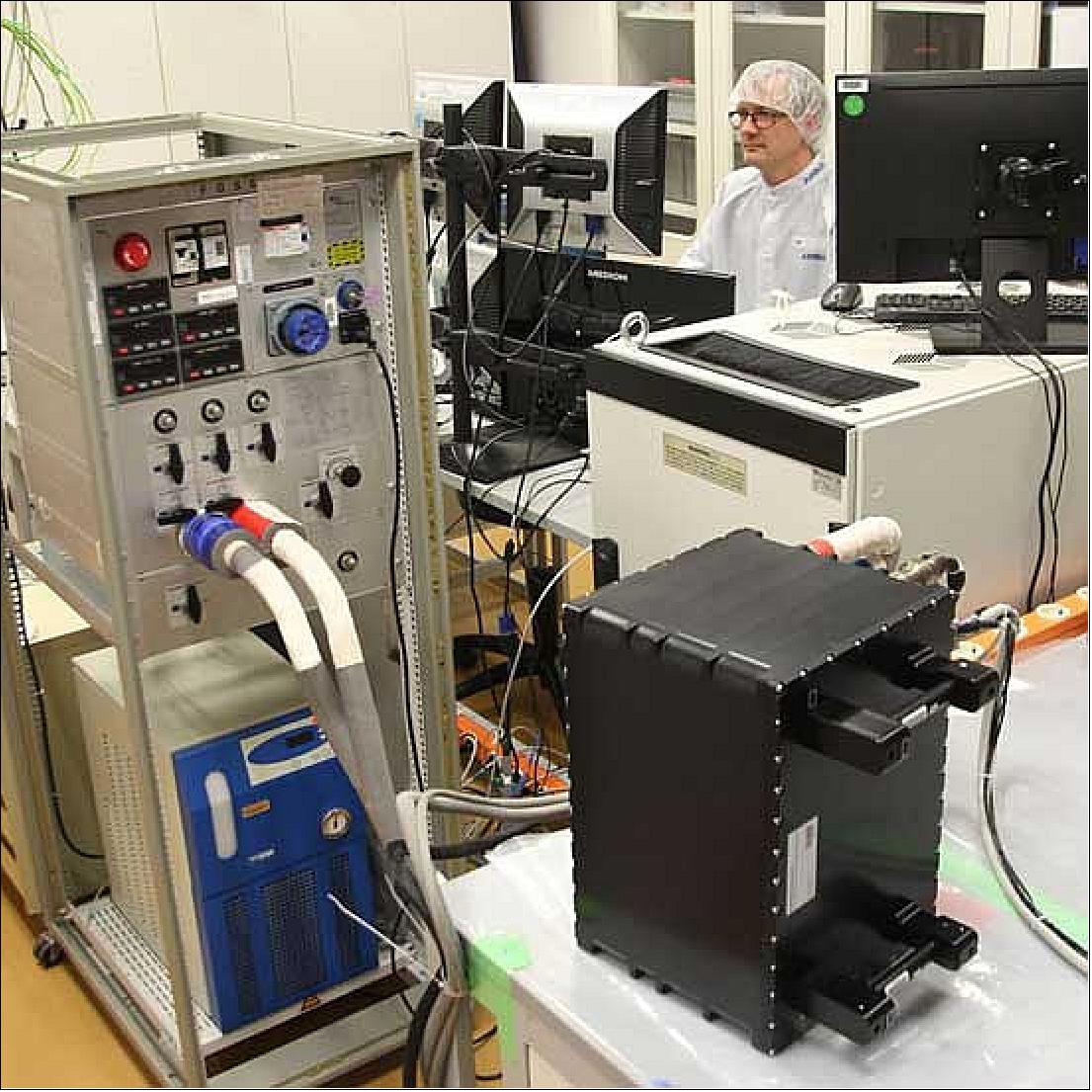
RUBI will study the phenomena of phase transition and heat transfer during the evaporation of fluids in microscopic and macroscopic dimensions. RUBI’s core element is a cell filled with fluid, which can be heated and cooled thermoelectrically. The boiling process is then triggered on a metal-coated glass heater using a laser. High-resolution cameras record the formation and growth of vapour bubbles in both the visible and infrared spectrum.
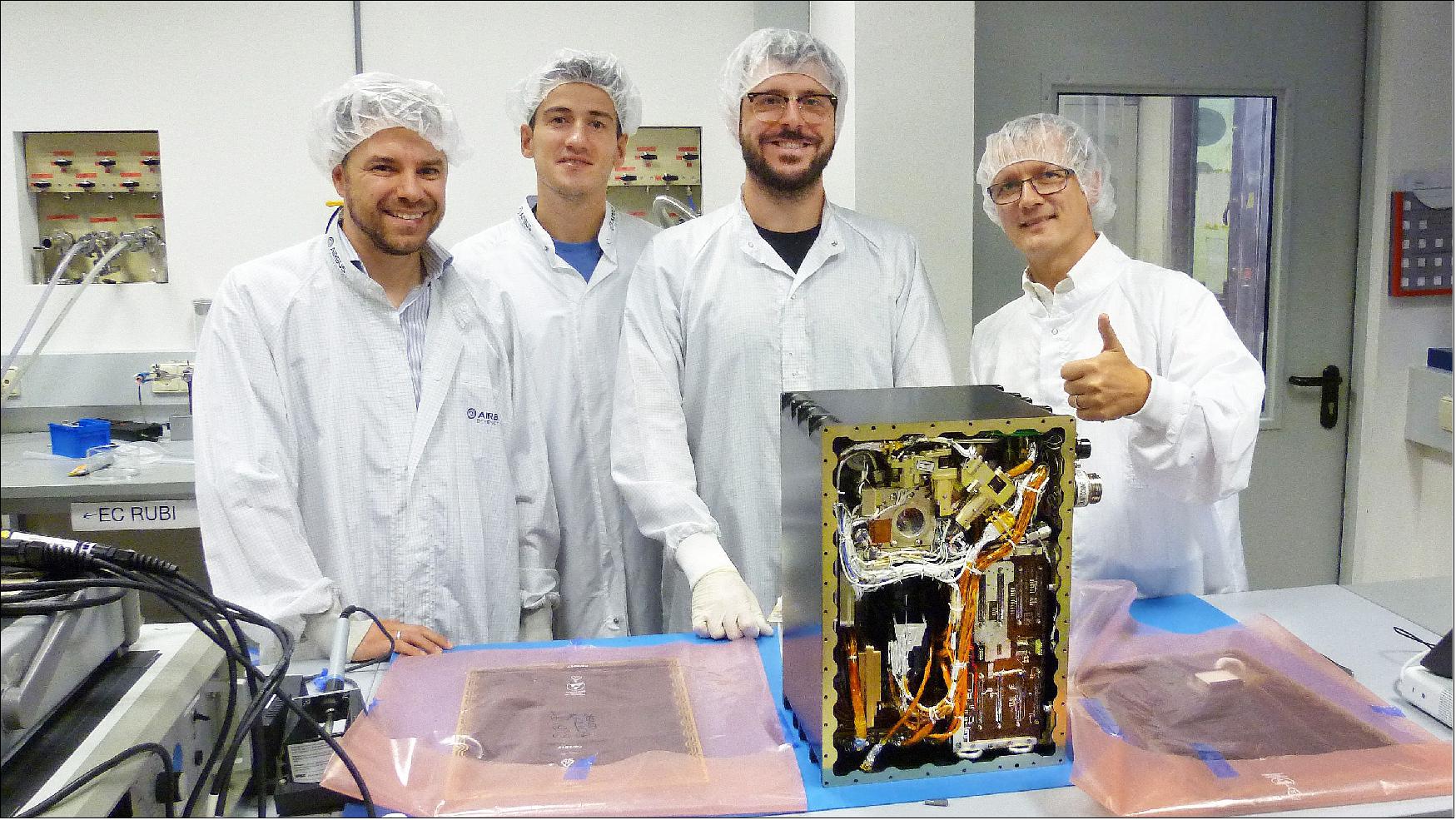
Launch
RUBI was launched on 25 July 2019 as part of the SpaceX CRS-18 (Commercial Resupply Service) mission to the ISS on 25 July 2019 (22:01 UTC). SpaceX launched its CRS-18 mission from Space Launch Complex 40 (SLC-40) at Cape Canaveral Air Force Station, Florida. Dragon separated from Falcon 9’s second stage about nine minutes after liftoff and will attach to the space station on Saturday, July 27. 5)
Orbit: Near circular orbit, altitude of ~400 km, inclination = 51.6º.
ESA astronaut Luca Parmitano is set to install RUBI in the Columbus module of the ISS during his five-month ‘Beyond’ mission (from July to December 2019). The fluid experiment will then be operated and controlled by the Belgian User Support and Operation Center (B-USOC) in Brussels.
Mission Status
• On board the European Columbus module of the International Space Station (ISS), January 26, 2021, will mark the end of two RUBI experiment sessions inside the Fluid Science Laboratory (FSL) rack. The FSL rack can host experiments for the study of the dynamics of fluids in space and RUBI — the Reference mUltiscale Boiling Investigation — is expanding our knowledge on the boiling process. At B.USOC (Belgian User Support and Operation Centre), the operators were in charge of this complex ESA instrument. 6)
- After the first successful RUBI session, ESA decided to initiate a second session to increase the science output, completing set points that had been left out in the first session, and attempting new conditions closer to the very limits of what the instrument could do. As X marks the spot for success, RUBI-X was a fact. The complete mission hosted 622 science runs (with 3 repetitions for each run), creating a huge amount of nucleate boiling bubbles and recording 12,5 TB of imagery and science measurements recorded on-board. Providing the scientists with plenty of data for analysis.
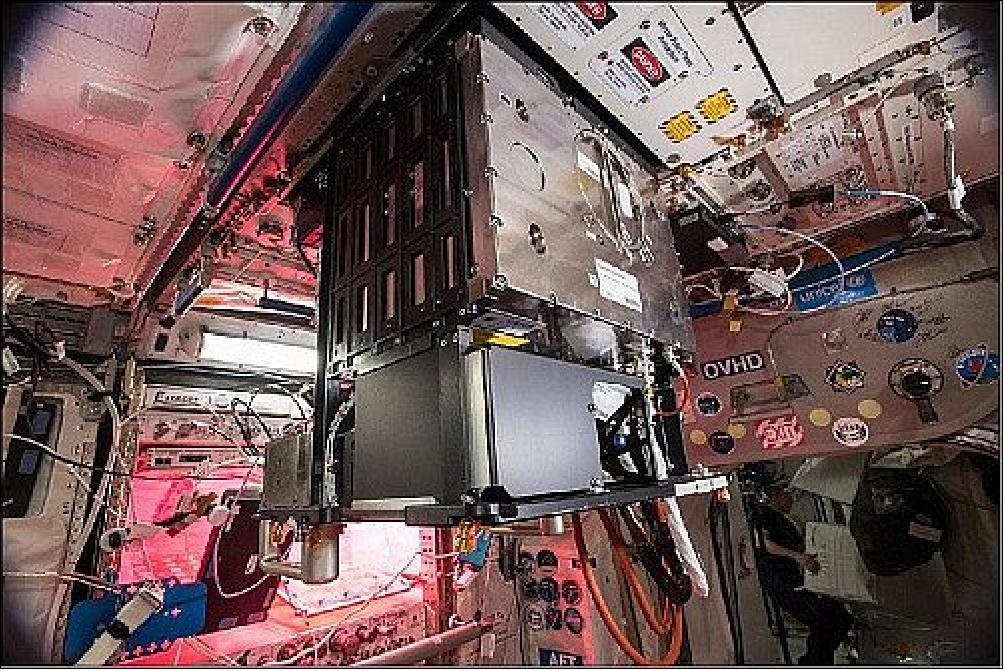
- On Tuesday (26 January), NASA Astronaut Shannon Walker will remove the RUBI container from the FSL rack and install the SMD container for the upcoming Soft Matter Dynamics mission that will also initiate additional science sessions studying the evolution of granular matter and foams in microgravity. This complex crew activity is also coordinated and real-time supported by the operators at B.USOC.
Background
- The Belgian User Support and Operations Centre (B.USOC) is responsible for the implementation of European payloads on board the International Space Station on behalf of the European Space Agency (ESA). It acts as the link between the scientists and the ISS environment and is responsible for preparing and operating those experiments. B.USOC operators are in contact with other ground control stations across Europe in order to make sure that these experiments are executed as expected and according to the needs of the scientists. Experiments start with a commissioning phase that requires a 24/7 based console coverage to perform a functional checkout. Later throughout the mission, this can be reduced.
- B.USOC has been responsible for quite an extensive list of payloads since the launch of the Columbus module in 2008. The external platforms SOLAR and ASIM, the PCDF rack, the METERON robotics project, and the Fluid Science Laboratory that can host a multitude of experiments. The latter is RUBI (Reference mUltiscale Boiling Investigation), soon to be replaced by CompGran-2 in the Soft Matter Dynamics (SMD) Experiment Container.
- The main goal of the RUBI experiment was to expand our knowledge about the boiling process within a fluid. In your everyday kitchen on Earth, gravity plays an important role in this process through buoyancy of the created bubbles. The ISS microgravity environment is therefore ideal to study the fundamental physics that would otherwise be hidden by gravity effects. RUBI’s main component is the fluid cell that is surrounded by heaters to reach near-boiling temperatures. Instruments to accurately control and monitor the boiling process include the Substrate Heater with a nucleation site where the boiling is initiated by a laser, a high-speed Black&White camera and a high speed infrared camera to capture images of the generated bubbles. An electrode within the fluid cell gives the scientists the possibility to observe the effects of an electric field on the bubbles, a pump can produce a flow to study how bubbles can be carried away by it and accurate temperature sensors are able to pinch through the bubbles like a needle.
- With RUBI and RUBI-X, 847 + 622 scientific runs were performed producing more than 12.5 TB of data that is being analyzed by the scientists. Besides telemetered values from each science run, the largest share of this data is coming from the High Speed Black&White and infrared cameras to monitor the boiling process. Having real-time access to the downlinked images to assess the progress and success of each run is producing the most delightful images of bubbles in microgravity providing that extra touch of joy for the operator on console. In order for the scientists to cope with that amount of data, automation was key to extract valuable data and process it.
- At the end of January 2021, the next FSL experiment, CompGran-2, will take place, starting with a commissioning phase during which the operator is on console 24/7 to test extensively every sub-systems of the experiment before proceeding with the science runs. CompGran-2 is a re-flight of the Compact Granular experiment operated for the first time in 2018.
Belgian Contribution:
a) Université Libre de Bruxelles is part of the research team (ULB- Transfers Interfaces and Processes, Prof. P. Colinet).
b) Lambda-X, in Nivelles, took part of the optics development.
c) Space Applications Services, in Zaventem, developed the new Video Management Unit of FSL.
• 22 December 2020: 7)
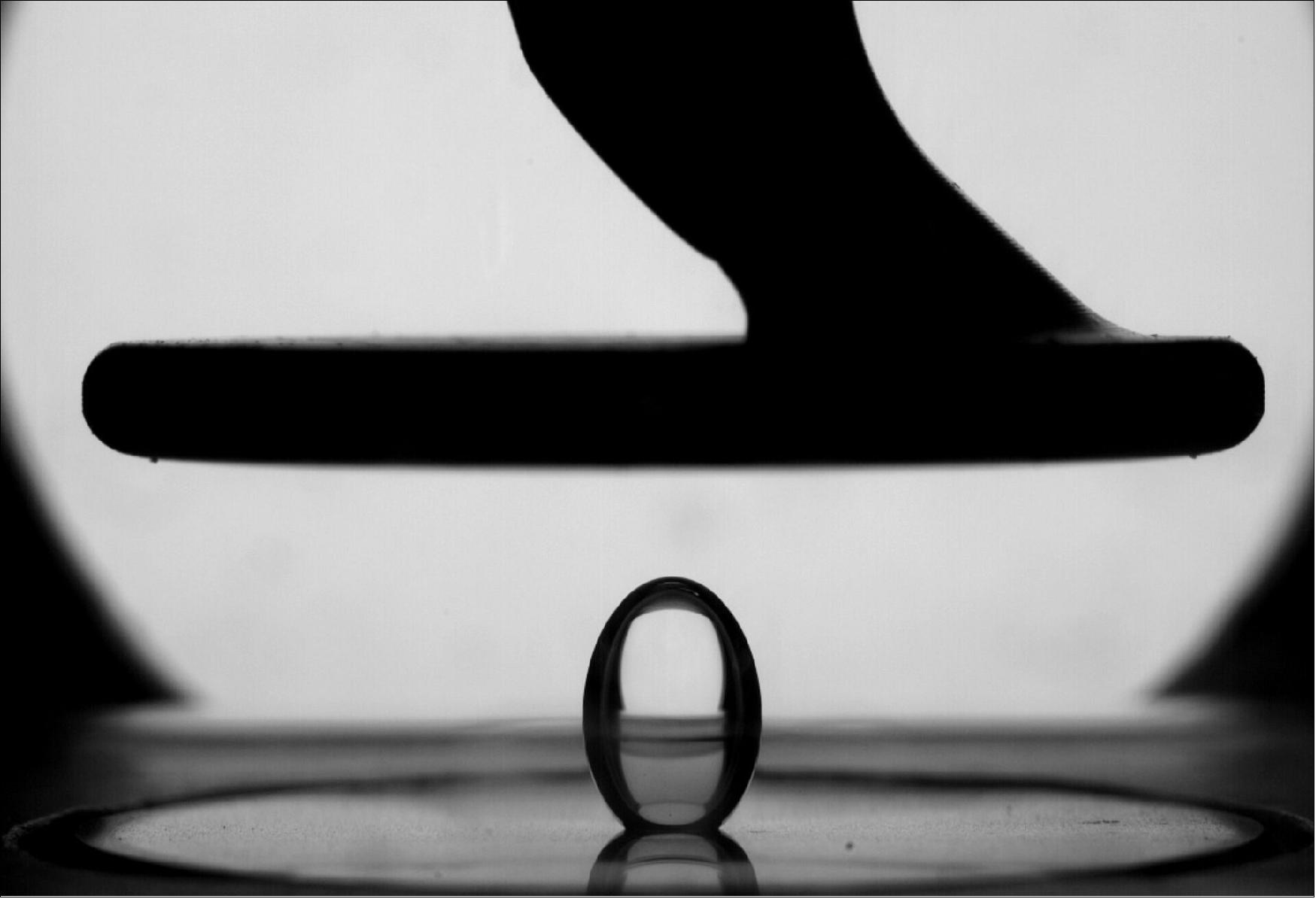
- Understanding how boiling behaves in weightlessness is imperative because gravity plays an important role. Without gravity, boiling takes place in slow motion and produces larger bubbles. This has allowed scientists to observe and measure effects that are too fast and too small on Earth.
- The experiment is also installed with an electrode to observe the effect of an electric field on the bubbles, enabling scientists to observe and quantify the effect of external forces.
- “Boiling is an extremely efficient way of getting rid of excess heat. This research could therefore provide very valuable information for improving the thermal management systems in space as well as in terrestrial applications,” says ESA project scientist Daniele Mangini.
- With this insight and more accurate calculations of the boiling process, products such as laptops can be improved and made more compact.
- Built by Airbus for ESA and housed in the Fluid Science Laboratory in the Columbus module, Rubi was installed by ESA astronaut Luca Parmitano in August 2019. Since then it has generated bubbles under controlled conditions using a special heater.
- The bubble imaged in Figure 4 is a follow on to the highly successful experiment. Called Multiscale Boiling X, the science on-going over the holidays is looking further at how things keep cool.
• June 9, 2020: Did you know that in microgravity you can better study the boiling process? — Boiling is a very common process in our everyday life. For instance, we usually boil water to cook or to clean. The boiling process is common in many engineering fields such as environmental applications and industrial chemical processes. 8)
- Understanding the dynamics of boiling is essential to improve energy production and conversion in power plants, and to design future space applications like cryogenic fuel storage and propulsion.
- On Earth the process happens too fast to be accurately observed and measured. But experiments conducted in low gravity environments, like on the International Space Station, allow us to observe phenomena like phase transition and the onset of bubbles much more clearly.
- Such studies may lead to increase the energy efficiency of several application also here on Earth, from Power plants to thermal management systems used in electric vehicles, laptops, and smartphones just to cite a few examples.
• November 13, 2019: Two months ago the first space bubble marked the beginning of the Multiscale Boiling experiment, known affectionately as Rubi. Since then over 200 science runs on bubble formation and growth with shear flow and electric field experiments continued. 9)
- Rubi generates bubbles using a special heater to expand our knowledge of the boiling process in microgravity. Boiling is relevant for many industrial applications, such as energy conversion, food and chemical processes.
- Larger and slower bubbles will allow scientists to observe and measure effects that are too fast and too small on Earth. Results could be key to design cryogenic fuel storage, more compact laptops and cooling electronics in space.
• September 10, 2019: Things got heated on the International Space Station this week after the Multiscale Boiling experiment, known as Rubi, was successfully switched on. 10)
- ESA astronaut Luca Parmitano installed the shoe box-sized container studying the boiling process in the Fluid Science Laboratory of the Columbus module after its arrival on a Dragon cargo resupply mission in August.
- The experiment is now in full swing and generated its first bubble under controlled conditions.
- Scientists will also observe and quantify the effect of external forces on the boiling process.
- Rubi is equipped with an electrode to assess the effect of the electric field on the bubbles, as well as a small pump that, when activated, will get the liquid moving to evaluate flow on the boiling process.
- Why space bubbles? - Scientists are investigating the boiling process in space mainly for two reasons.
- Running this experiment in weightlessness has the advantage that the boiling process takes place in slow motion and the bubbles generated are much larger than on Earth allowing researchers to investigate details of the process in high resolution.
- Boiling is a common process in many applications such as refrigeration or cooling of high-performance electronic devices. This research will provide valuable information for designing thermal management systems in a more efficient way, both in space as well as on Earth.
- Rubi will run for five months on the International Space Station, during which time more than 600 test runs are planned.
- Follow the Rubi experiment on social media for regular updates and more bubbly images and videos.
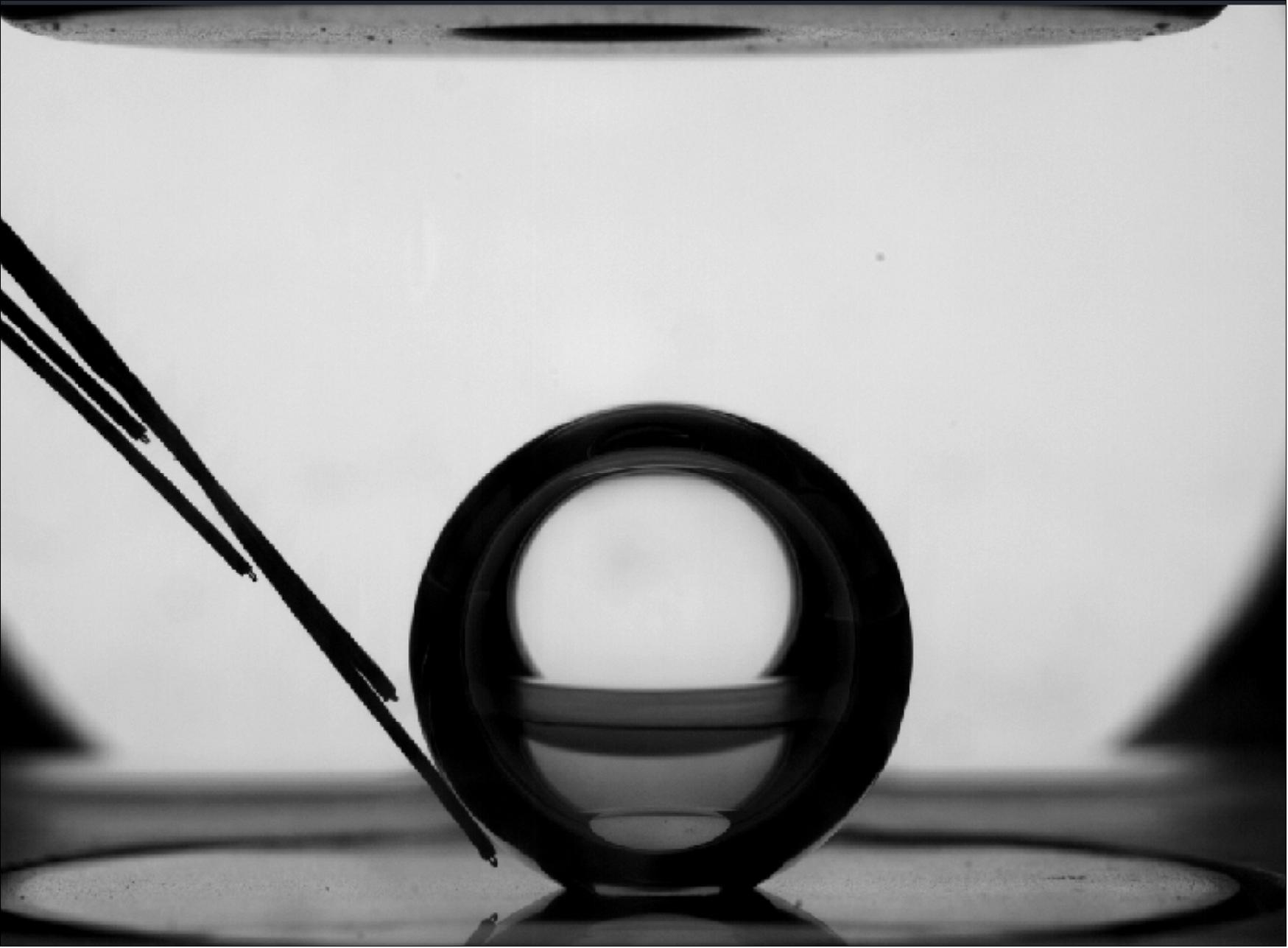
• On 27 July 2019, two days after its launch from Florida, the SpaceX Dragon cargo spacecraft was installed on the Earth-facing side of the International Space Station’s Harmony module at 12:01 p.m. EDT. 11)
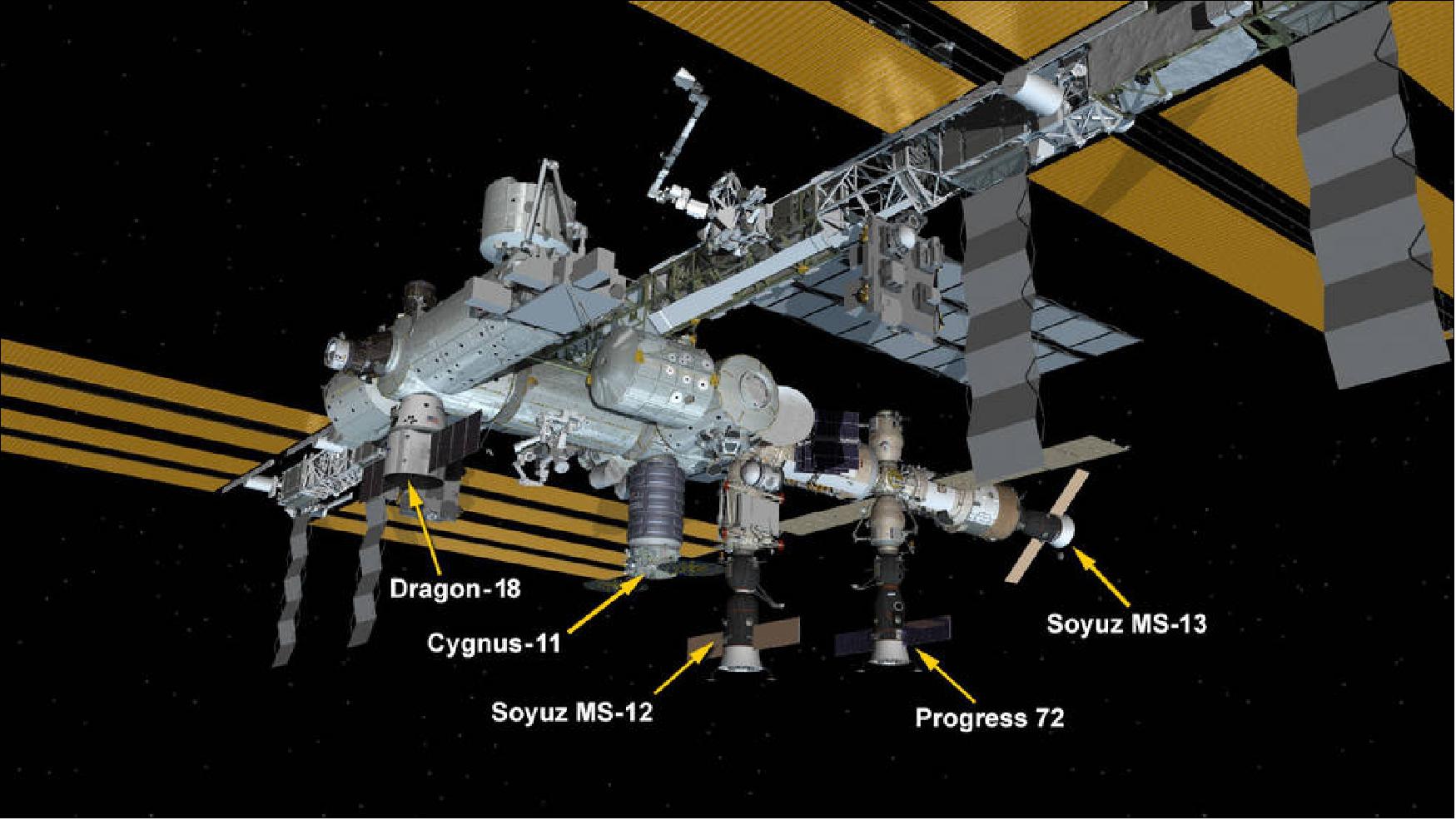
- The 18th contracted commercial resupply mission from SpaceX (CRS-18) delivers more than 5,000 pounds of research, crew supplies and hardware to the orbiting laboratory.
- A key item in Dragon’s unpressurized cargo section is International Docking Adapter-3 (IDA-3). Flight controllers at mission control in Houston will use the robotic arm to extract IDA-3 from Dragon and position it over Pressurized Mating Adapter-3, on the space-facing side of the Harmony module. NASA astronauts Nick Hague and Andrew Morgan, who arrived at the station Saturday, July 20, will conduct a spacewalk in mid-August to install the docking port, connect power and data cables, and set up a high-definition camera on a boom arm.
- Robotics flight control teams from NASA and the Canadian Space Agency will move the docking port into position remotely before the astronauts perform the final installation steps. IDA-3 and IDA-2, which was installed in the summer of 2016, provide a new standardized and automated docking system for future spacecraft, including upcoming commercial spacecraft that will transport astronauts through contracts with NASA.
- After Dragon spends approximately one month attached to the space station, the spacecraft will return to Earth with cargo and research.
• On July 27 2019, Dragon was captured at the ISS. While the ISS was traveling over southern Chile, astronauts Nick Hague and Christina Koch of NASA grappled Dragon at 9:11 a.m. EDT using the space station’s robotic arm Canadarm2. 12)
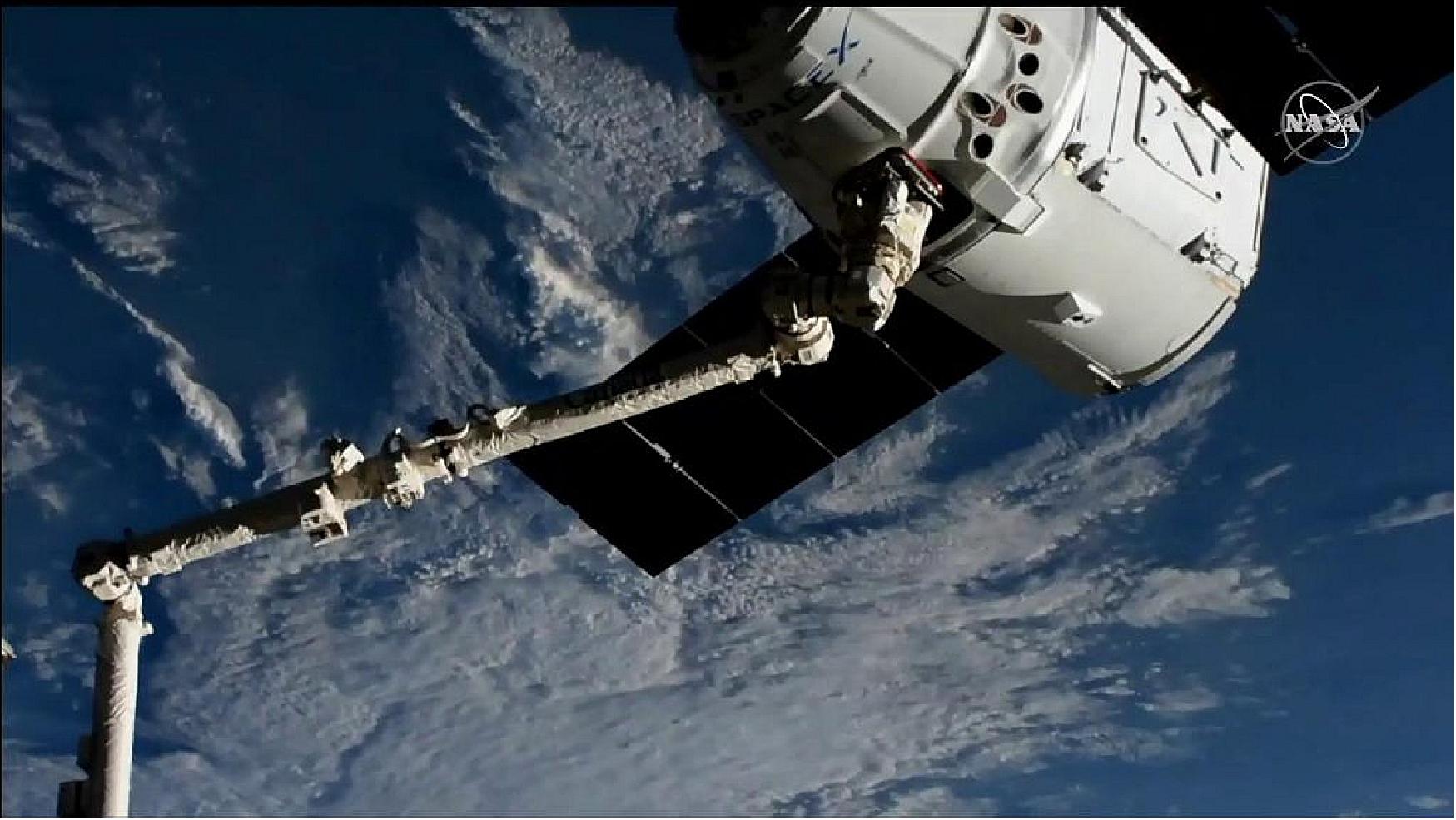
- Ground controllers will now send commands to begin the robotic installation of the spacecraft on bottom of the station’s Harmony module.
RUBI Science
• August 8, 2019: Bubbles are soon to be made in space as part of an experiment that combines scientific insight with an objectively cool process on International Space Station. 13)
- The Reference mUltiscale Boiling Investigation experiment, known affectionately as RUBI, aims to expand our knowledge of the boiling process.

Plug and Boil
- A lot of science will take place in a container the size of a large shoebox. Built by Airbus for ESA and housed in the Fluid Science Laboratory in the Columbus module, RUBI will generate bubbles under controlled conditions using a special heater.
- A high-speed camera will record how the bubbles behave, while an infrared camera measures the temperature of the heated region.
- It sounds simple enough, but what makes RUBI complex is that scientists are eager to observe and quantify the effect of external forces.
- With no gravity to disperse the bubbles, the science teams installed an electrode to observe the effect of an electric field on the bubbles.
- The experiment container also contains a small pump that, when activated, will get the liquid moving to evaluate the effect on the boiling process.
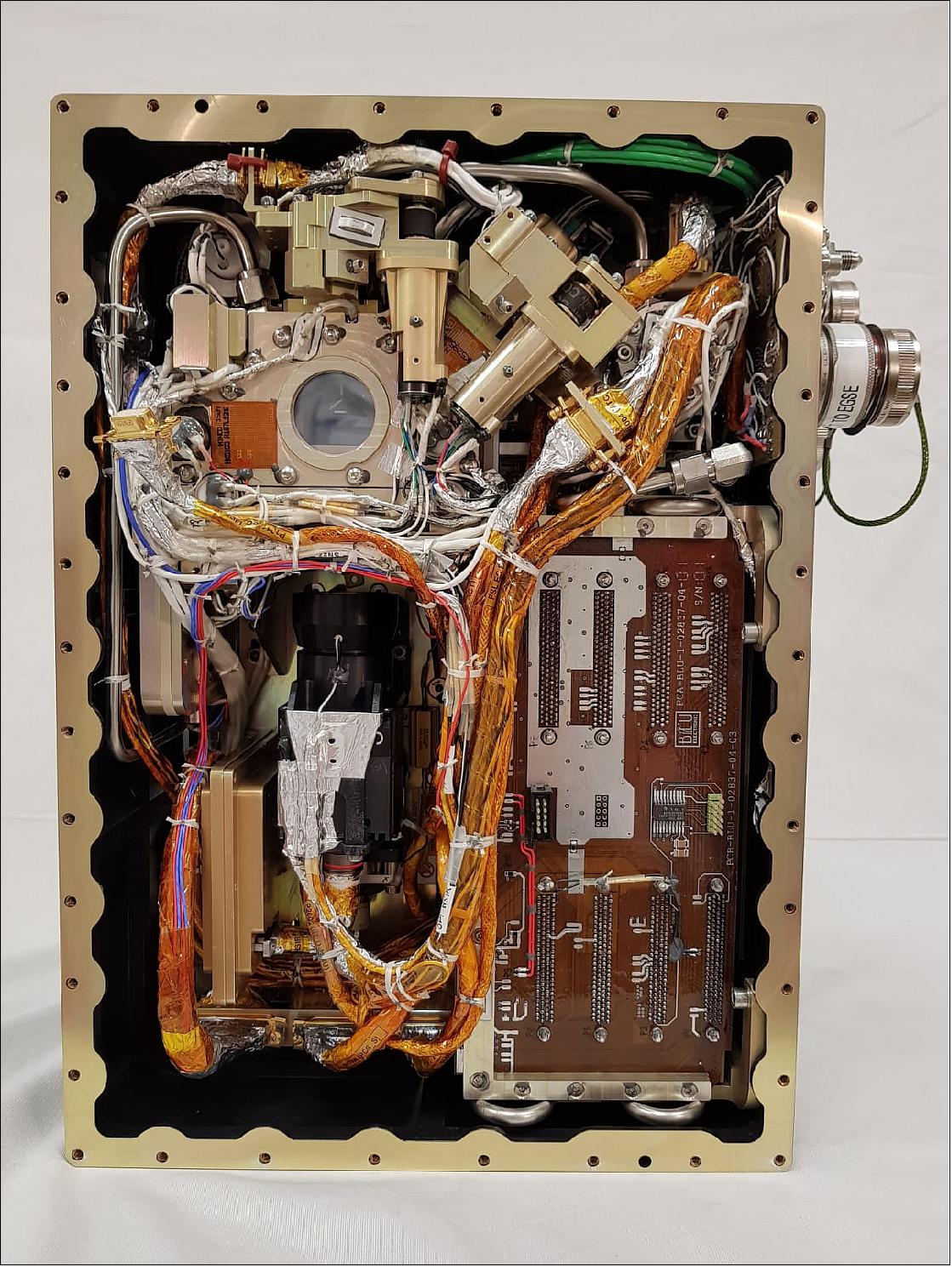
Why Space Bubbles?
- "Making sure equipment and computer chips stay at the right temperature is of vital importance, otherwise their lifetime, as well as their performance, could decrease abruptly," says ESA project scientist Daniele Mangini.
- “Boiling is an extremely efficient way of getting rid of excess heat. It could therefore be used to keep components of future spacecraft at their optimal temperature,” continues Daniele.
- Back on Earth, better heat transfer technology means a lower impact on nature, as products such as laptops can cool down more efficiently.
- ESA astronaut Luca Parmitano will install RUBI on 9 August and the experiment will run for five months on the International Space Station, during which time more than 600 test runs are planned.

Institutions of the Multiscale Boiling Science Team:
• Technische Universität Darmstadt, Institute of Technical Thermodynamics
• Aix Marseille Université
• University of Pisa
• Institut de Mécanique des Fluides de Toulouse
• Institute of Thermal-Fluid Dynamics, ENEA
• Transfers Interfaces and Processes, Université Libre de Bruxelles
• LAboratoire PLAsma et Conversion d’Energie Université Paul Sabatier
• Università degli Studi di Padova
• University of Thessaloniki
• University of Ljubljana
• Institute of Thermophysics, Novosibirsk, Russia
• Kobe University
• Hyogo University
• University of Maryland
References
1) Catherine Colin,Olivier Kannengieser,Wladimir Bergez,Michel Lebon,Julien Sebilleau,Michaël Sagan,Sébastien Tanguy, ”Nucleate pool boiling in microgravity:Recent progress and future prospects,” Science Direct, Volume 345, Issue 1, January 2017, Pages 21-34, https://doi.org/10.1016/j.crme.2016.10.004, URL: https://reader.elsevier.com/reader/sd/pii/
S1631072116301012?token=E169E28538A84FE395FCEF3CB337AC3F70
C3B69473D71A42B9553D83C2920597198FBD29EEBF8091A3C337F89880A76C
2) Nils Schweizer, Marco Stelzer, Olaf Schoele-Schulz, Gerold Picker, Hans Ranebo, Jan Dettmann, Oliier Minster, Balazs Toth, Josef Winter, Lounes Tadrist, Peter Stephan, Walter Grassi, Paolo di Marco, Catherine Colin, Gian Celata Piero, John Thome, Oleg Kabov, ”RUBI -a Reference mUltiscale Boiling Investigation for the Fluid Science Laboratory,” 38th COSPAR Scientific Assembly, 18-15 July 2010, Bremen, Germany
3) CatherineColin, OlivierKannengieser,WladimirBergez, MichelLebon, JulienSebilleau, MichaëlSagan, SébastienTanguy, ”Nucleate pool boiling in microgravity: Recent progress and future prospects,” Science Direct, C. R. Mecanique, Volume 345, Issue 1, January 2017, Pages 21-34, https://doi.org/10.1016/j.crme.2016.10.004
4) ”RUBI – Full steam ahead for the ISS,” Airbus DS Press Release, 2 July 2019, URL: https://www.airbus.com/content/dam/corporate-topics/publications/
press-release/EN-Airbus-SpS-Press-Release-RUBI-Full-steam-ahead-for-the-ISS.pdf
5) ”SpaceX Soars Sending a Dragon on a Falcon to Resupply the ISS ... CRS-18 Mission Success So Far,” Satnews Daily, 25 July 2019, URL: http://www.satnews.com/story.php?number=125292080
6) ”Dot the i's and cross the t's ... and mark the X: Belgian space control centre (B.USOC) operators are wrapping up the RUBI-X mission,” Royal Belgian Institute for Space Aeronomy, 26 January 2021, URL: https://www.aeronomie.be/en/news/2021/
dot-and-cross-ts-and-mark-x-belgian-space-control-centre-busoc-operators-are-wrapping
7) ”Space bauble,” ESA Science & Exploration, 22 December 2020, URL: https://www.esa.int/ESA_Multimedia/Images/2020/12/Space_bauble
8) ”Boiling. We research. You benefit,” ESA Science & Exploration, 9 June 2020, URL: http://www.esa.int/ESA_Multimedia/Videos/2020/06/Boiling._We_research._You_benefit
9) ”Behind the scenes – space-age physics — Space bubbles,” ESA, 13 November 2019, URL: http://www.esa.int/Science_Exploration/Human_and_Robotic_Exploration
/Behind_the_scenes_space-age_physics
10) ”Space Bubble,” ESA, Space in images, 10 September 2019, URL: http://www.esa.int/spaceinimages/Images/2019/09/Space_bubble
11) Mark Garcia, ”Dragon Installed to Station’s Harmony Module for Cargo Operations,” NASA, 27 July 2019, URL: https://blogs.nasa.gov/spacestation/tag/dragon/
12) Mark Garcia, ”Dragon Captured With New Science Experiments,” NASA, 27 July 2017, URL: https://blogs.nasa.gov/spacestation/tag/dragon/
13) ”Bubbles in space,” ESA human and robotic exploration, 8 August 2019, URL: http://www.esa.int/Our_Activities/Human_and_Robotic_Exploration/Research/Bubbles_in_space
The information compiled and edited in this article was provided by Herbert J. Kramer from his documentation of: ”Observation of the Earth and Its Environment: Survey of Missions and Sensors” (Springer Verlag) as well as many other sources after the publication of the 4th edition in 2002. - Comments and corrections to this article are always welcome for further updates (eoportal@symbios.space).